This blog post has the content from the presentation I delivered at ManhattanJS. There are a couple of slides and a repo to go with it.
I will show how to reach into a live Angular application and overwrite features on the fly.
I will also show how to load the application from the Node environment and
how to unit test private code without source modifications. You can try the steps yourself
by cloning the repo and stepping through the tagged commits step-1, step-2, etc.
Start
Create a static page with HTML5 boilerplate code that shows a list of names
to greet, something like this (saved as index.html)
<!DOCTYPE html>
<html>
<head>
<title>hello world</title>
</head>
<body>
<h2>Hello</h2>
<ul>
<li>John</li>
<li>Mary</li>
</ul>
</body>
</html>
You can view this page by opening the file in any browser (I used Chrome in this demo) directly from the command line
open index.html
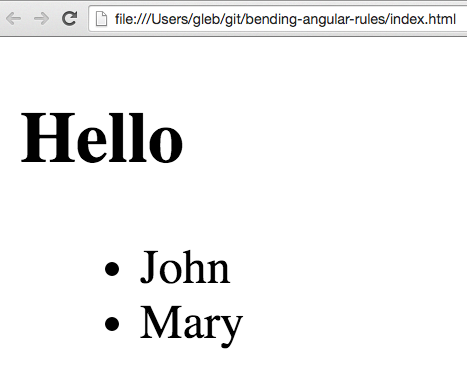
Showing list of names: step-1
Let us allow the user to enter new names to be greeted. We will need to add an input text field and a button. We can add them to our static markup for now
<!DOCTYPE html>
<html>
<head>
<title>hello world</title>
</head>
<body>
<h2>Hello</h2>
<ul>
<li>John</li>
<li>Mary</li>
</ul>
Enter a name <input type="text" /><button>Add</button>
</body>
</html>
Let us make this application live by adding a dash of Angular framework
npm install angular
Add Angular controller to the page, it will be injected a special object $scope to hold
the list of names
<!DOCTYPE html>
<html>
<head>
<title>hello world</title>
<script src="node_modules/angular/angular.js"></script>
<script>
angular.module('HelloApp', [])
.controller('HelloController', function ($scope) {
$scope.names = ['John', 'Mary'];
});
</script>
</head>
<body ng-app="HelloApp" ng-controller="HelloController">
<h2>Hello</h2>
<ul>
<li ng-repeat="name in names track by $index">{{ name }}</li>
</ul>
Enter a name <input type="text" /><button>Add</button>
</body>
</html>
You need track by $index if you want to allow duplicate names in the list.
We can control the list of names to be shown from the outside. From the browser's console type
angular.element(document.body).scope().names
// ["John", "Mary"]
angular.element(document.body).scope().names.push('Dave')
angular.element(document.body).scope().$apply();
// the list is reflected in the DOM
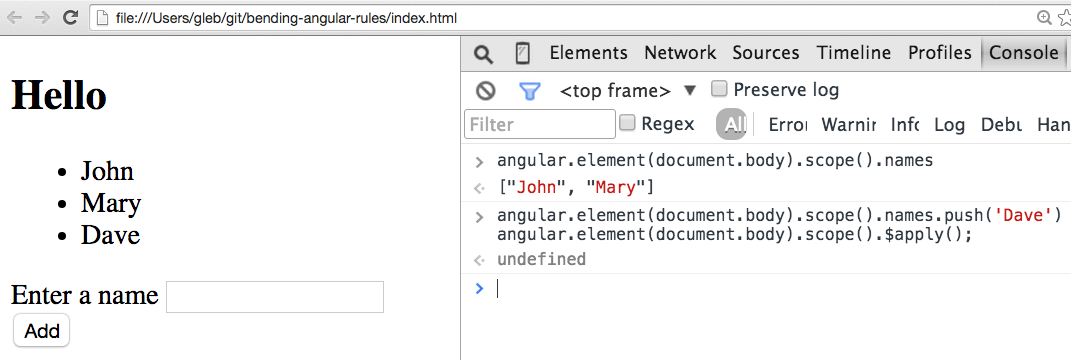
We can access the scope of any DOM element (or surrounding it) via element.scope() method.
Since the $scope is simply a plain object, to let Angular know we have modified it and would
like to see the changes, we need to call scope.$apply() method.
Add entered name to the list: step-2
Let us connect our static input field and the button to the list of names.
We can change the HTML markup to bind the input value to the property newName on the $scope
Enter a name <input type="text" ng-model="newName" />
And we can call a method on the $scope (see the pattern) whenever the user clicks the button
<button ng-click="addName()">Add</button>
We need to write the addName() method, otherwise nothing is happening.
1 | .controller('HelloController', function ($scope) { |
Nice! The newName property was created implicitly by the input field bound to the model property newName.
Since we are using built-in click handler ng-click, we did not have to call $scope.$apply() - it is done
automatically for us.
Clear the entered value: step-3
We notice that the added name is NOT cleared from the input field.

We never set the scope
property to the undefined or an empty string, thus it just stayed in the DOM. While it would be simple
to write the following code, we want to experiment first
1 | $scope.addName = function () { |
Can we add the missing delete line to the scope method dynamically? Yes we can, right from the browser's console
1 | var scope = angular.element(document.body).scope(); |

BOOM! We dynamically extended an Angular application! This is a very useful approach:
accessing methods from the $scope to wrap them on the fly. For example, we can monitor
the method's execution. From the Chrome console:
monitor(scope.addName);
// Click "Add" button
// VM946:1 function scope.addName called
We can even find where the code is without knowing it. Let us say, we want to stop when the
button is clicked and we get into the addName method
debug(angular.element(document.body).scope().addName)
// Click "Add" button
// Debugger pauses at the first line in `addName`
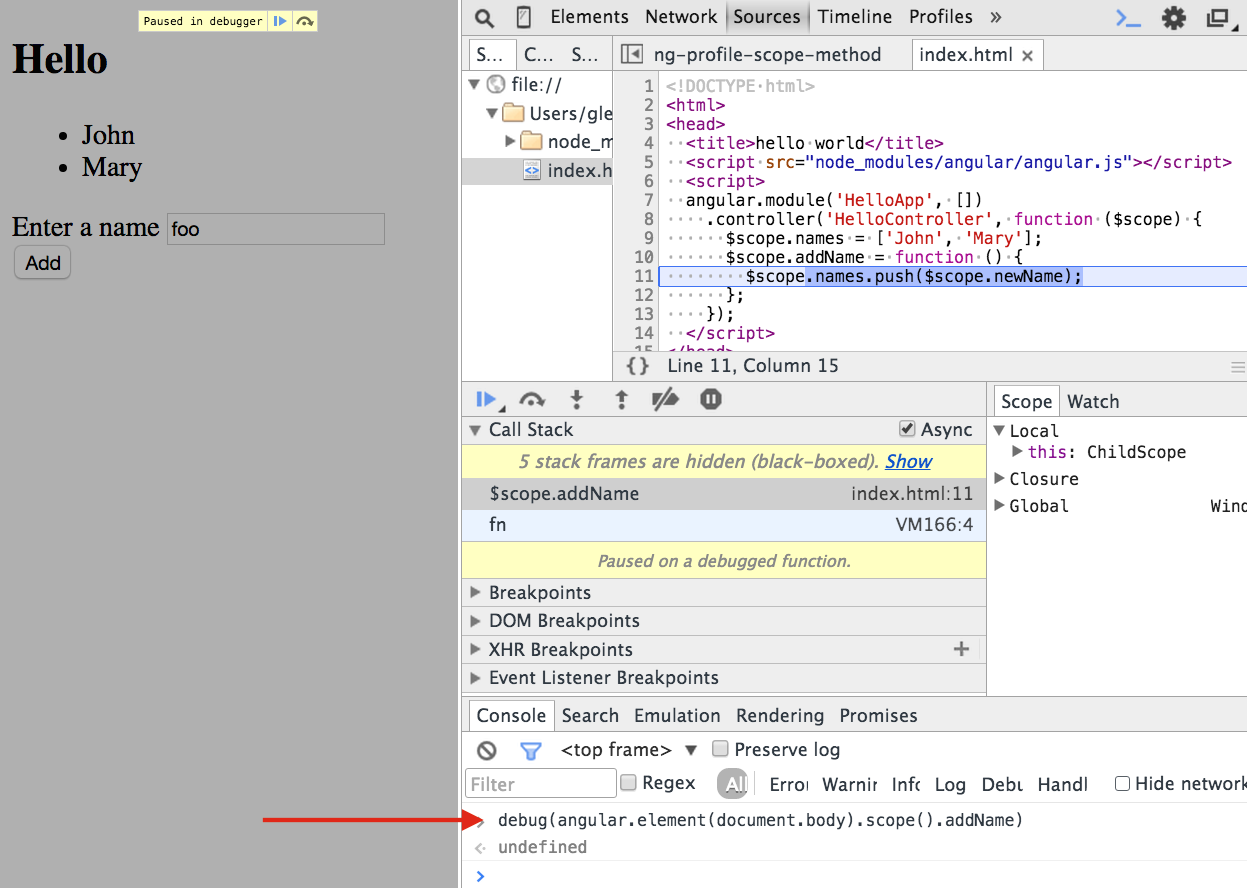
We can even profile long-running methods using Chrome's DevTools by "wrapping" the method
in console.profile() and console.profileEnd() commands.
See Improving Angular web app performance example for details.
Calling the server to get the new name: step-4
Let us show how we can bend JavaScript closure rules a little. We can get a reference to the
$scope object and the $scope.addName`, thus we can override the method completely at run-time
1 | var scope = angular.element(document.body).scope(); |
This is a complete replacement. What if we wanted to do something else - like partial replacement?
Here is a good example. Let us say, $scope.addName grabbed the name not from the input field, but
from a server.
1 | <button ng-click="addName()">Add</button> from the server |
1 | .controller('HelloController', function ($scope, $http) { |
Well, we are running straight from the file system using open index.html. When we click "Add"
button we get an Ajax error
Error: Failed to execute 'send' on 'XMLHttpRequest': Failed to load 'file:///new/name'

Duh! We don't have a server to respond.
Bending the rules to mock the server response: step-5
Let us bend the JavaScript closure rules to mock the server. Here is how we are going to
overwrite the addName method at runtime from the browser's console to fake the $http service.
1 | var $http = { |
Click the "Add" button.
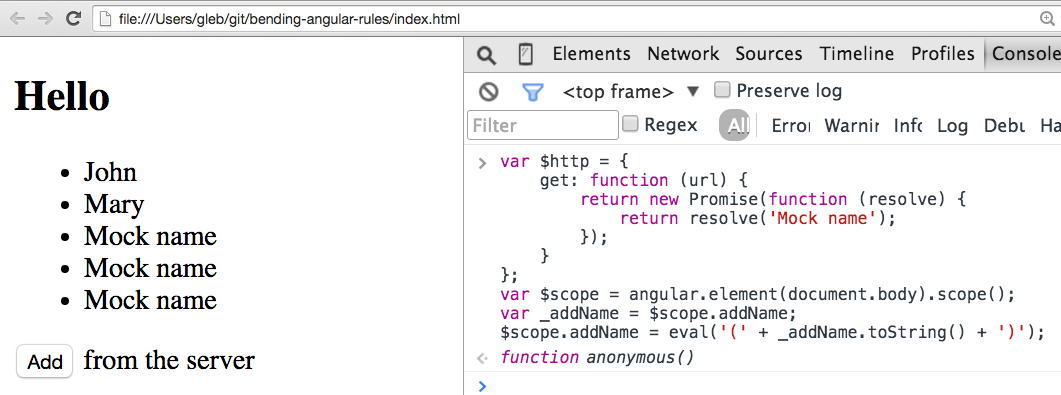
BOOM! The mock promise-returning function from the browser's console
overwrote a variable inside the parent's closure of a $scope method.
We knew that addName is using $http and $scope variables. Thus we replaced
the function by evaluating the $scope.addName method as is, but with our defined
variables; $scope was the same, but $http was a fake one. The JavaScript eval
takes the current scope as the parent scope, thus we can substitute new functionality
into the existing application dynamically.
Really useful library based on this principle is ng-wedge, it is a mock response utility for a live application.
Why can't we load Angular app directly from NodeJS? step-6
We have installed the AngularJS library using Node Package Manager
npm install angular
Yet, if we move the application's code into a separate javascript file, we cannot load it directly. Try moving the JavaScript into a separate file
1 | // app.js |
$ node app.js
/git/bending-angular-rules/app.js:1
(function (exports, require, module, __filename, __dirname) { angular.module('
^
ReferenceError: angular is not defined
Of course, we loaded Angular framework first in our HTML page, before loading the app.js file.
// index.html
<script src="node_modules/angular/angular.js"></script>
<script src="app.js"></script>
Can we load AngularJS framework itself directly from Node? Not directly
$ node node_modules/angular/angular.js
/git/bending-angular-rules/node_modules/angular/angular.js:28686
})(window, document);
^
ReferenceError: window is not defined
It would be very cool if we could load Angular without window.
While this is possible, I prefer a different approach to this problem.
We will simulate the full browser environment (window, document)
under NodeJS. We can do this using benv module that puts a very simple API on top of
jsdom.
npm install benv
Let us create a file that shows loading AngularJS framework and app.js from Node
1 | // load.js |
You can now execute this file load.js from Node to verify that the synthetic environment has been
setup and the Angular framework has been loaded.
$ node load.js
window is object
document is object
angular is object
window.angular === angular true
Instead of printing diagnostic messages, let us load our Angular application. We can now use simple CommonJS require included with Node for this
1 | // load.js |

Nice, we are instantiating parts of Angular app directly from the command line using Node without using any browsers.
Why NodeJS require matters: step-7
Why did we spend time loading the Angular code under Node? Why is Node's built-in require
anything but the ordinary implementation of the CommonJS standard? Turns out it has nifty features
we can exploit.
- It has a preprocessor hook that can run the loaded source through user-supplied callback function before evaluating it.
- The built-in
requiremethod can be overwritten completely using the same closure trick we have seen before, see Hacking Node require
Both of these features were used to implement really-need - a replacement for NodeJS require
method. Some of the cool features it can do: rewrite the loaded source, bust module cache, rebuild the compiled
exported values, pass arguments to the module and mock __dirname and __filename.
1 | require = require('really-need'); |
The pre hook is especially useful for source rewriting.
We could use it to instrument the source code with code coverage statements.
Or we could use it to "grab" references to private functions. Why would one need to do this?
To enable quick unit testing of private functions, expressions and variables. For example
if we had file foo.js that exports nothing, we could run the source through a preprocessor
whenever someone required it.
1 | // foo.js |
and the evaluated source code would be something like
1 | // transformed code from foo.js |
Imagine the new name to be added to the list comes from a private function inside the file app.js.
1 | // app.js |
It certainly works - we can see the effect even from the command line
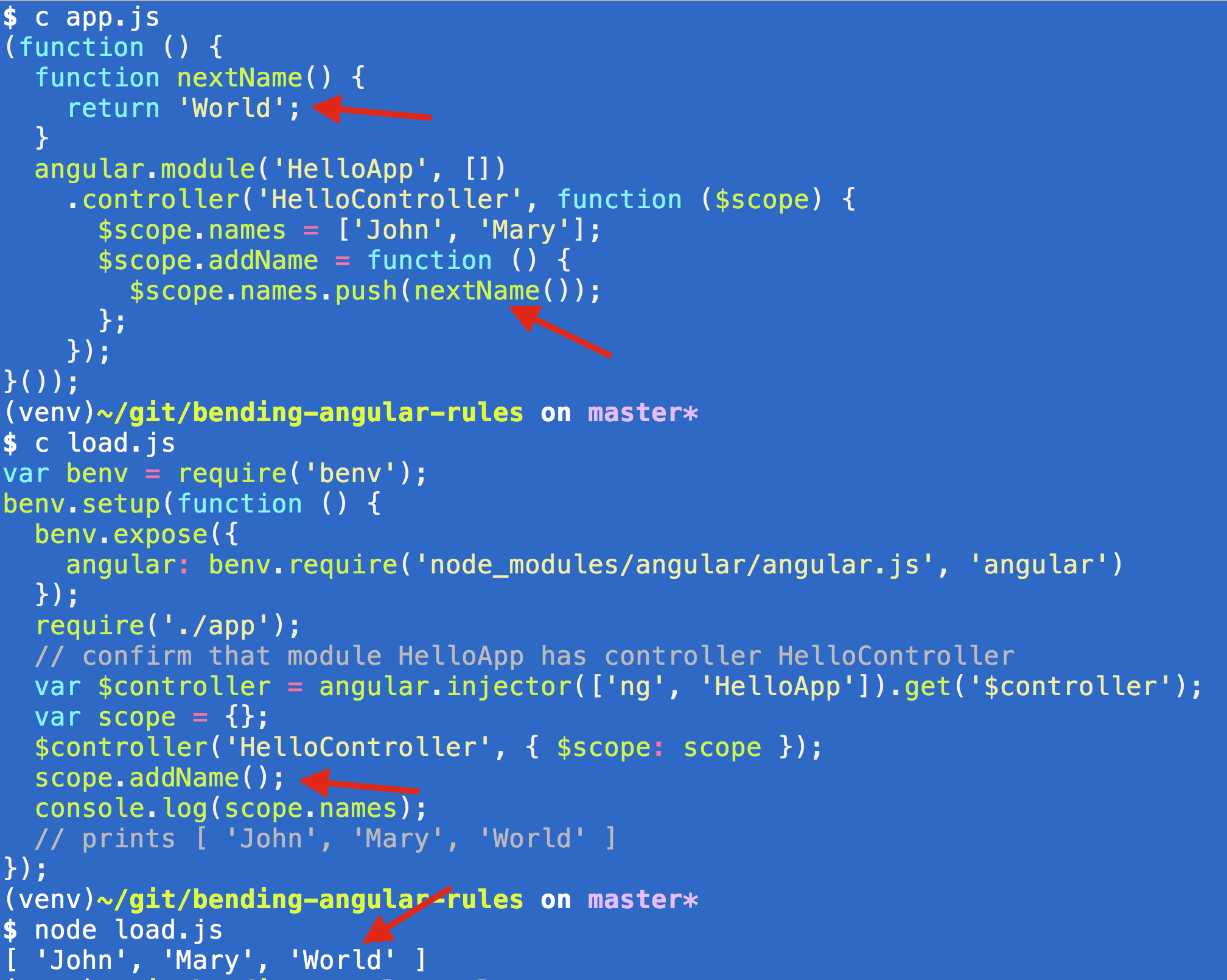
Can we unit test the function nextName to see how it behaves? Only indirectly by constructing a controller,
adding a mock scope object, calling addName, etc. Such a long process. Or we could use a hook into NodeJS
loader using really-need that can grab a reference to any function for us. All we need to tell the loader
is the signature of the function we need. We have implemented the Angular initialization (using benv
and NodeJS hook) in a single helper module ng-dice
npm install ng-dice
ng-dice stands for Angular Dependency Injection and Code Extraction library.
Create a simple BDD unit test for Mocha or Jasmine test framework
1 | // next-name-spec.js |
We can confirm that the unit test passes
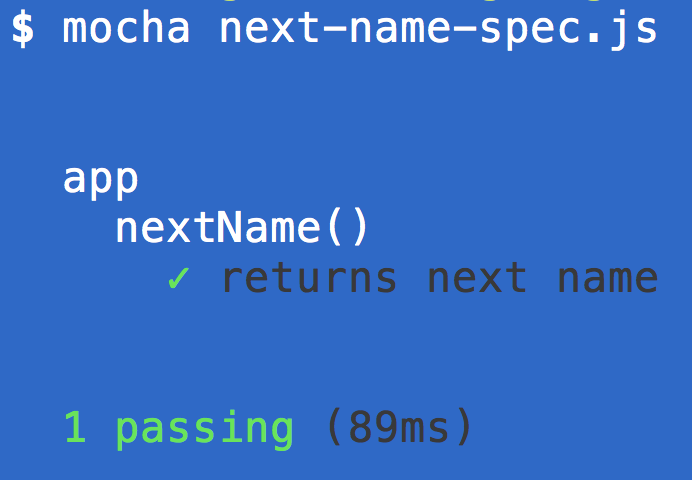
Here is what the unit test has accomplished
- Loaded the CommonJS module
next-name-spec.js - The
ngDicefunction has loaded the AngularJS library fromnode_modulespath - It then loaded using a patched NodeJS
requiremethod fileapp.js, rewriting the source to insert code to grab the reference to a function with the signaturenextName() - The Angular application code loaded fine using the synthetic browser environment
- When we called the
codeExtract()function passed back to our user code, we got the reference to the actualfunction nextName()fromapp.js - We called
nextName()directly and confirmed its output.
One can argue that unit testing private functions and variables goes against the principles of black box testing. Yes, but it pays to bend the rules a little.